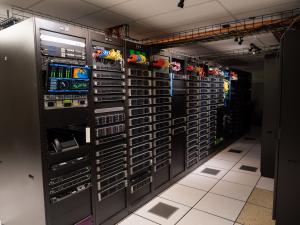The Broadcast Educational Media Commission (BEMC) plays a critical role in providing news and information programming to Ohio citizens through eight public television and 15 public radio stations across the state. Supported by the Ohio Legislature and funded by taxpayer dollars, BEMC and its partners help citizens learn about current events, alert them to public emergencies, and educate children and adults.
OARnet has supported BEMC’s statewide operation through its fiber-optic backbone, which provides resiliency and redundancy to ensure that broadcasts are available 24/7 with no service interruption. That predictability is especially important when BEMC and its partners must deliver breaking news—such as the outbreak of COVID-19 or a tornado threat—and reach as many members of the public as quickly as possible via direct integration with Ohio’s Emergency Alert System.
In 2024, OARnet and BEMC completed the first phase of a major effort to upgrade the commission’s dedicated backbone and core infrastructure to strengthen and secure its statewide service. In addition to the technology refresh, the project marks a major step forward in the improvement of the resiliency of the network. Engineers from BEMC and OARnet have used the maintenance windows to replace equipment as an opportunity to proactively perform failover testing of the network and applications.

Photo credit: BEMC
“The BEMC project is a great demonstration of the OARnet engineering team’s ingenuity in action,” said Pankaj Shah, OARnet executive director. “In addition to updating our backbone to serve BEMC’s rising bandwidth needs, our engineers were able to devise custom solutions to ensure the viability of this important statewide service.”
OARnet upgraded connectivity on the BEMC backbone from 1 Gigabit per second (Gbps) to 10 Gbps as part of the technology refresh, and also built a weather map to help BEMC evaluate the performance of its network 24/7. In addition, OARnet engineers helped BEMC design and construct a new data center to support its live services and are assisting with equipment upgrades at all of the public media affiliates across the state.
“We spent a long time in the design phase, as we wanted to remove bottlenecks, improve resiliency and redundancy where we can, avoid single points of failure and ensure traffic flow,” said Eric Wortman, BEMC assistant chief of engineering, about the comprehensive project. “A lot of fiber went in, which required a lot of work from OARnet’s team.”
Much of the work is happening at the BEMC headquarters in Columbus, which is home to the Joint Master Control that has served as a central hub for public broadcasting content since 2015. In an effort to control their capital and operating expenses, Ohio stations chose to centralize their master control units at the BEMC instead of continuing to operate decentralized systems. BEMC now oversees one of the largest public Joint Master Control operations in the nation.
“The Joint Master Control is unique in that the Ohio stations pay nothing. So those who are using it are experiencing extreme savings plus on-air accuracy,” said Geoffrey Phillips, BEMC executive director.
Ohio public television stations create their programming schedules and submit them to BEMC, which compiles the content from its program storage or satellite transmissions from the Public Broadcasting Service (PBS) and international broadcast organizations. BEMC takes in about 1,300 pieces of media—from long-form content such as television shows to interstitial promotions—each month.

BEMC prides itself on its consistency of service. From May 2023 to April 2024, for example, its uptime was 99.981%, with eight of those weeks boasting 100%. In the Joint Master Control room, staff monitor dozens of television screens that display what Ohio public stations are broadcasting at any given moment, from Toledo to Cincinnati. They watch for signs of broadcast interruptions, which may be caused by bad weather or equipment failure.
“We take ownership of all of those elements, even if they are beyond our control,” Phillips said. “When a viewer sits down to watch a program, if they don’t see what they were expecting, we take responsibility for that. We hold our accuracy numbers up against anyone else’s.”
During the recent upgrade, OARnet needed to carefully plan the switchover from the old to new infrastructure, as there could be no downtime for the statewide broadcasts. Engineers migrated the broadcast traffic in stages over time to avoid interruptions, said Aaron Wise, director of networking at OARnet.
“BEMC’s application performance is highly visible – thousands of people are watching it, so there is not a lot of margin for error,” Wise said. “The design of the network must support BEMC’s on-air mission.”
BEMC relies on systems that require network protocols that are different from those used by other OARnet customers in the education, government, research or health care spaces. OARnet’s engineering team has in-house proficiency with live video technologies that complements the expertise of the BEMC staff.
OARnet’s ability to cater to these unique public broadcasting needs has made it a valuable partner to BEMC. Previously, BEMC worked with various telecommunication entities around the state to support its service, but collaborating with OARnet has simplified and improved communications and operations, said Craig Stevenson, BEMC chief of engineering and broadcast operations.
“OARnet provides superb service to us,” Stevenson said. “It’s unlike anything I’ve seen in my 30 years in the industry.”
Written by Andrea Gibson
Since 1987, OARnet has delivered technology-based solutions that reduce costs, increase productivity and improve customer service. As a division of the Ohio Department of Higher Education's(link sends e-mail) Ohio Technology Consortium(link sends e-mail) (OH-TECH), OARnet serves Ohio's education, health care, public broadcasting and government communities. Other members of the consortium include the Ohio Supercomputer Center(link sends e-mail) (OSC) and the Ohio Library and Information Network(link sends e-mail) (OhioLINK).